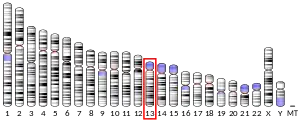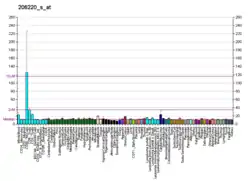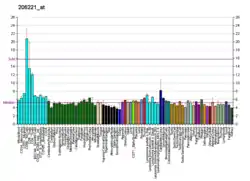| RASA3 | |||||||||||||||||||||||||||||||||||||||||||||||||||
|---|---|---|---|---|---|---|---|---|---|---|---|---|---|---|---|---|---|---|---|---|---|---|---|---|---|---|---|---|---|---|---|---|---|---|---|---|---|---|---|---|---|---|---|---|---|---|---|---|---|---|---|
| Identifiers | |||||||||||||||||||||||||||||||||||||||||||||||||||
| Aliases | RASA3, GAP1IP4BP, GAPIII, RAS p21 protein activator 3 | ||||||||||||||||||||||||||||||||||||||||||||||||||
| External IDs | OMIM: 605182 MGI: 1197013 HomoloGene: 7217 GeneCards: RASA3 | ||||||||||||||||||||||||||||||||||||||||||||||||||
| |||||||||||||||||||||||||||||||||||||||||||||||||||
| |||||||||||||||||||||||||||||||||||||||||||||||||||
| |||||||||||||||||||||||||||||||||||||||||||||||||||
| |||||||||||||||||||||||||||||||||||||||||||||||||||
| |||||||||||||||||||||||||||||||||||||||||||||||||||
| Wikidata | |||||||||||||||||||||||||||||||||||||||||||||||||||
| |||||||||||||||||||||||||||||||||||||||||||||||||||
Ras GTPase-activating protein 3 is an enzyme that in humans is encoded by the RASA3 gene.[5][6][7]
The protein encoded by this gene is member of the GAP1 family of GTPase-activating proteins. The gene product stimulates the GTPase activity of normal RAS p21 but not its oncogenic counterpart. Acting as a suppressor of RAS function, the protein enhances the weak intrinsic GTPase activity of RAS proteins resulting in the inactive GDP-bound form of RAS, thereby allowing control of cellular proliferation and differentiation. This family member is an inositol 1,3,4,5-tetrakisphosphate-binding protein, like the closely related RAS p21 protein activator 2. The two family members have distinct pleckstrin-homology domains, with this particular member having a domain consistent with its localization to the plasma membrane.[7]
Interactions
References
- 1 2 3 ENSG00000185989 GRCh38: Ensembl release 89: ENSG00000280477, ENSG00000185989 - Ensembl, May 2017
- 1 2 3 GRCm38: Ensembl release 89: ENSMUSG00000031453 - Ensembl, May 2017
- ↑ "Human PubMed Reference:". National Center for Biotechnology Information, U.S. National Library of Medicine.
- ↑ "Mouse PubMed Reference:". National Center for Biotechnology Information, U.S. National Library of Medicine.
- ↑ Cullen PJ, Hsuan JJ, Truong O, Letcher AJ, Jackson TR, Dawson AP, Irvine RF (Sep 1995). "Identification of a specific Ins(1,3,4,5)P4-binding protein as a member of the GAP1 family". Nature. 376 (6540): 527–30. Bibcode:1995Natur.376..527C. doi:10.1038/376527a0. PMID 7637787. S2CID 4283160.
- ↑ Lockyer PJ, Bottomley JR, Reynolds JS, McNulty TJ, Venkateswarlu K, Potter BV, Dempsey CE, Cullen PJ (Feb 1998). "Distinct subcellular localisations of the putative inositol 1,3,4,5-tetrakisphosphate receptors GAP1IP4BP and GAP1m result from the GAP1IP4BP PH domain directing plasma membrane targeting". Curr Biol. 7 (12): 1007–10. doi:10.1016/S0960-9822(06)00423-4. PMID 9382842.
- 1 2 "Entrez Gene: RASA3 RAS p21 protein activator 3".
- ↑ Briggs SD, Bryant S S, Jove R, Sanderson S D, Smithgall T E (Jun 1995). "The Ras GTPase-activating protein (GAP) is an SH3 domain-binding protein and substrate for the Src-related tyrosine kinase, Hck". J. Biol. Chem. UNITED STATES. 270 (24): 14718–24. doi:10.1074/jbc.270.24.14718. ISSN 0021-9258. PMID 7782336.
Further reading
- Hata Y, Kikuchi A, Sasaki T, et al. (1990). "Inhibition of the ras p21 GTPase-activating protein-stimulated GTPase activity of c-Ha-ras p21 by smg p21 having the same putative effector domain as ras p21s". J. Biol. Chem. 265 (13): 7104–7. doi:10.1016/S0021-9258(19)39083-0. PMID 2158984.
- Hjermstad SJ, Briggs SD, Smithgall TE (1993). "Phosphorylation of the ras GTPase-activating protein (GAP) by the p93c-fes protein-tyrosine kinase in vitro and formation of GAP-fes complexes via an SH2 domain-dependent mechanism". Biochemistry. 32 (39): 10519–25. doi:10.1021/bi00090a031. PMID 7691175.
- Briggs SD, Bryant SS, Jove R, et al. (1995). "The Ras GTPase-activating protein (GAP) is an SH3 domain-binding protein and substrate for the Src-related tyrosine kinase, Hck". J. Biol. Chem. 270 (24): 14718–24. doi:10.1074/jbc.270.24.14718. PMID 7782336.
- Lockyer PJ, Vanlingen S, Reynolds JS, et al. (1999). "Tissue-specific expression and endogenous subcellular distribution of the inositol 1,3,4,5-tetrakisphosphate-binding proteins GAP1(IP4BP) and GAP1(m)". Biochem. Biophys. Res. Commun. 255 (2): 421–6. doi:10.1006/bbrc.1999.0217. PMID 10049724.
- El-Daher SS, Patel Y, Siddiqua A, et al. (2000). "Distinct localization and function of (1,4,5)IP(3) receptor subtypes and the (1,3,4,5)IP(4) receptor GAP1(IP4BP) in highly purified human platelet membranes". Blood. 95 (11): 3412–22. doi:10.1182/blood.V95.11.3412. PMID 10828023.
- Cozier GE, Lockyer PJ, Reynolds JS, et al. (2000). "GAP1IP4BP contains a novel group I pleckstrin homology domain that directs constitutive plasma membrane association". J. Biol. Chem. 275 (36): 28261–8. doi:10.1074/jbc.M000469200. PMID 10869341.
- Koehler JA, Moran MF (2001). "RACK1, a protein kinase C scaffolding protein, interacts with the PH domain of p120GAP". Biochem. Biophys. Res. Commun. 283 (4): 888–95. doi:10.1006/bbrc.2001.4889. PMID 11350068.
- Walker SA, Kupzig S, Lockyer PJ, et al. (2003). "Analyzing the role of the putative inositol 1,3,4,5-tetrakisphosphate receptor GAP1IP4BP in intracellular Ca2+ homeostasis". J. Biol. Chem. 277 (50): 48779–85. doi:10.1074/jbc.M204839200. PMID 12356770.
- Strausberg RL, Feingold EA, Grouse LH, et al. (2003). "Generation and initial analysis of more than 15,000 full-length human and mouse cDNA sequences". Proc. Natl. Acad. Sci. U.S.A. 99 (26): 16899–903. Bibcode:2002PNAS...9916899M. doi:10.1073/pnas.242603899. PMC 139241. PMID 12477932.
- Ota T, Suzuki Y, Nishikawa T, et al. (2004). "Complete sequencing and characterization of 21,243 full-length human cDNAs". Nat. Genet. 36 (1): 40–5. doi:10.1038/ng1285. PMID 14702039.
- Rush J, Moritz A, Lee KA, et al. (2005). "Immunoaffinity profiling of tyrosine phosphorylation in cancer cells". Nat. Biotechnol. 23 (1): 94–101. doi:10.1038/nbt1046. PMID 15592455. S2CID 7200157.
- Battram AM, Durrant TN, Agbani EO, et al. (2016). "The Phosphatidylinositol 3,4,5-trisphosphate (PI(3,4,5)P3)-binder Rasa3 Regulates Phosphoinositide 3-kinase (PI 3-kinase)-dependent Integrin αIIbβ3 Outside-in Signaling". J. Biol. Chem. 292 (5): 1691–1704. doi:10.1074/jbc.M116.746867. PMC 5290945. PMID 27903653.





